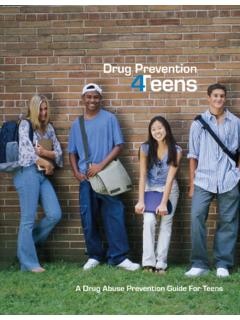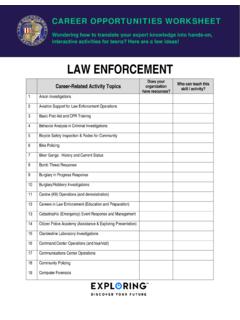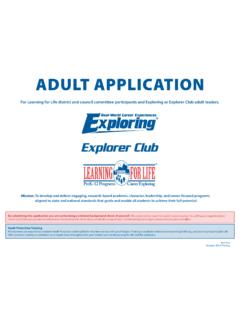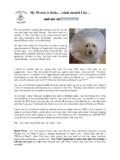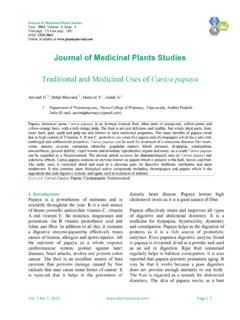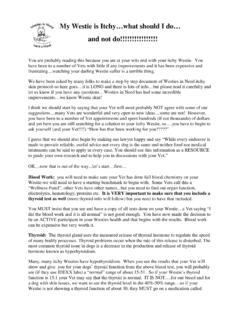Transcription of Drug Prevention 4Teens - Exploring
1 A Drug Abuse Prevention Guide For TeensDrug PreventionTeens4 Introduction:Substance Abuse Guide For Teens 1 Part One:Today s Drug Problem 2 Extent of Problem 2 Drugs of Abuse 3 Cannabis Heroin Cocaine 4 Methamphetamine Prescription Drugs 5 GHB Ecstasy 6 LSD PCP Ketamine 7 Anabolic Steroids Inhalants Over the Counter (OTCs) 8 Costs to Society 10 Why Do Young People Use Drugs? 11 Attitudes About Drugs 13 What Is Addiction? 15 Drug Treatment 15 What About Drug Legalization? 16 Part Two:Drug Prevention and Awareness 17 Principles of Prevention 18 Drug Prevention Programs 20 Prevention Resources 20 Part Three:What You Can Do 23 How Teens Can Assist WithDrug Awareness Programs 23 Drug Prevention Projects 25 Drug PreventionTable of ContentsLearning for Life has partnered with the Drug Enforcement Admin-istration (DEA), the federal agency best known for dismantling international and domestic drug trafficking organizations.
2 DEA is also a leader in the Prevention community and works with schools, parents, communities, and the public to provide accurate informa-tion on the harm drugs cause. Learning for Life groups, posts, and participants embrace these efforts in our communities and, with DEA Special Agents across the nation, hope to have an impact on teen drug use in our for Life and the Drug Enforcement Administration con-sider young people to be a valuable resource in preventing sub-stance abuse. Whether you make a personal decision not to use drugs, help educate your peers about the dangers of drugs, or inform members of the community about the damages caused by drug use and trafficking, you are making a difference in combating this , we are pleased to present this program guide to supple-ment Learning for Life Abuse Guide For Teens1 Extent of ProblemPart One.
3 Today s Drug ProblemDrug use in the United States is a serious problem, but much progress has been made through effective drug Prevention and enforcement programs during the past decade. Teen drug use decreases when young people perceive that drug use is risky, and good drug Prevention programs help teens understand how and why drugs are kids don t take drugs. According to a recent government survey drug use rates have decreased since 2001. Kids are rejecting marijuana, LSD, steroids, ecstasy, methamphetamine, alcohol and tobacco.
4 They are also telling researchers that they know more about the dangers of drugs and that helps them say no to drugs. You can find detailed information on drug use in America from the following sources: Monitoring the Future National Survey on Drug Use and Health Substance Abuse and Mental Health Services Administration National Institute on Drug Abuse Office of National Drug Control Policy Drug Enforcement Administration are many illegal substances abused today. There are other substances, such as over-the-counter medications, household products, and legitimate pharmaceuticals (medicines) that are also abused.
5 This brief guide provides information on the most commonly abused drugs. Here are some facts which will help you understand the facts about illegal Controlled Substances Act (CSA) categorizes drugs into five categories (Schedules I-V) according to their medical use, potential for abuse, and safety. The most addictive drugs, and drugs which have no medical use, are in Schedule I. Federal penalties for manufacturing and/or distributing illegal drugs are based on the danger each drug poses to individuals and to the public.
6 There are several classes of drugs; each class has different properties and effects on the user. Narcotics: Narcotics (such as heroin, morphine, OxyContin, etc.) are used to dull the senses and reduce pain. Narcotics can be made from opium (from the opium poppy) or created in a laboratory (synthetic and semi-synthetic narcotics).Stimulants: Stimulants reverse the effects of fatigue on the body and brain. Sometimes they are referred to as uppers. Cocaine, amphetamines, methamphetamine and Ritalin are stimulant drugs.
7 Cocaine is derived from the coca plant grown in South America. Nicotine (found in tobacco) is also a : Substances included in this category are tranquilizers, sedatives, hypnotics, anti-anxiety medications and : Marijuana and hashish are substances referred to as cannabis and THC (delta-9-tetrahydrocanabinol) is the ingredient in cannabis which makes the user feel high. Hallucinogens: These substances alter the perceptions and moods of users. LSD, Ecstasy, PCP and Ketamine are made in laboratories, some of which are clandestine; non-manufactured hallucinogens include peyote and : Many common items such as glue, lighter fluid, paint products, cleaning fluids, gasoline, and propellants in aerosol cans contain chemicals that produce intoxicating effects similar to alcohol.
8 Inhalant abuse is the deliberate inhaling or sniffing of these products to get : Anabolic steroids are defined as any drug or hormonal substance that is chemically and pharmacologically related to testosterone and promotes muscle growth. Some steroids are used for legitimate medical reasons, but many are illegally manufactured and of AbuseDrug Effects:CannabisEffects: Euphoria, relaxed inhibitions, increased appetite, disorientation, impaired motor skills and concentration. Overdose Effects: Fa-tigue, paranoia, and possible psychosis.
9 CSA Schedule: Schedule I: Marijuana has no medical use. Schedule II: Marinol is a synthetic form of THC which can be pre-scribed for patients with particular medical conditions. Street Names: Pot, Grass, Sinsemilla, Blunts, Mota, Yerba, Grifa, Aunt Mary, Boom, Chronic (marijuana alone or marijuana with crack), Dope Ganja, Gang-3 Specific DrugsCannabisCannabis Sativa L. Marijuana is grown in the United States, Mexico, Canada, South Amer-ica, Asia, and other parts of the world. It can be cultivated outdoors and in indoor settings.
10 Marijuana is usually smoked and the effects are felt within minutes. Depending on the dosage and other variables, users can feel relaxed and have altered senses of smell, sight, taste and hearing, distorted senses of time, shifting sensory imagery, rap-idly fluctuating emotions, fragmentary thoughts, impaired memory and dulling of (delta-9-tetrahydrocanabinol) is the psychoactive ingredient found in the marijuana plant. In the 1970 s, the average THC content of illicit marijuana was less than one percent. Today most commercial grade marijuana from Mexico/Colombia and domestic outdoor cultivated marijuana has an average THC content of 4 to 6 percent, although some samples have tested as high as 25 percent doses of marijuana can result in hallucinations.
